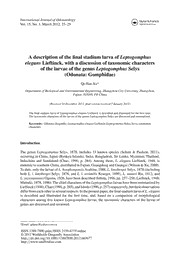
A description of the final stadium larva ofLeptogomphus elegansLieftinck, with a discussion of taxonomic characters of the larvae of the genusLeptogomphusSelys (Odonata: Gomphidae) PDF
Preview A description of the final stadium larva ofLeptogomphus elegansLieftinck, with a discussion of taxonomic characters of the larvae of the genusLeptogomphusSelys (Odonata: Gomphidae)
InternationalJournalofOdonatology Vol.15,No.1,March2012,25–29 A description of the final stadium larva of Leptogomphus elegans Lieftinck, with a discussion of taxonomic characters of the larvae of the genus Leptogomphus Selys (Odonata: Gomphidae) Qi-HanXu* DepartmentofBiologicalandEnvironmentalEngineering,ZhangzhouCityUniversity,Zhangzhou, Fujian363000,PRChina (Received10December2011;finalversionreceived7January2012) ThefinalstadiumlarvaofLeptogomphuselegansLieftinckisdescribedandillustratedforthefirsttime. ThetaxonomiccharactersofthelarvaeofthegenusLeptogomphusSelysarediscussedandsummarized. Keywords: Odonata;dragonfly;LeptogomphuselegansLieftinck;LeptogomphusSelys;larva;taxonomic characters Introduction The genus Leptogomphus Selys, 1878, includes 23 known species (Schorr & Paulson, 2011), occurringinChina,Japan(RyukyuIslands),India,Bangladesh,SriLanka,Myanmar,Thailand, Indochina and Sundaland (Chao, 1990, p. 284). Among them, L. elegans Lieftinck, 1948, is endemictosouthernChina,distributedinFujian,GuangdongandGuangxi(Wilson&Xu,2009). Todate,onlythelarvaeofL.hongkongensisAsahina,1988,L.lansbergeiSelys,1878(including both L. l. lansbergei Selys, 1878, and L. l. assimilis Krueger, 1899), L. sauteri Ris, 1912, and L.yayeyamensisOguma,1926,havebeendescribed(Ishida,1996,pp.257–258;Lieftinck,1948; Matsuki,1978,1996).ThechiefcharactersoftheLeptogomphuslarvaehavebeensummarizedby Lieftinck(1948),Chao(1990,p.285),andIshida(1996,p.257)respectively,buttheirobservations differfromeachotherinseveralrespects.Inthepresentpaper,thefinalstadiumlarvaofL.elegans is described and illustrated for the first time, and, based on a comparison of morphological characters among five known Leptogomphus larvae, the taxonomic characters of the larvae of genusarediscussedandreviewed. *Email:[email protected] ISSN1388-7890print/ISSN2159-6719online ©2012WorldwideDragonflyAssociation http://dx.doi.org/10.1080/13887890.2012.663677 http://www.tandfonline.com 26 Q.-H.Xu Descriptionofthefinalstadiumlarvaof LeptogomphuselegansLieftinck,1948 Specimensstudied In total nine larvae: 5(cid:2), 4(cid:3), Fujian Province, Zhangzhou City, Mountain Tianbao 24◦ 39(cid:3) N, 117◦ 31(cid:3) E,3May2007,leg.Xu,depositedintheDepartmentofBiologicalandEnvironmental Engineering, Zhangzhou City University, Fujian, China.Their identity was confirmed by com- parisonwiththeexuviaefromwhichanadultmalehadjustemerged,whichwasobservedand collectedinthefieldatthesamelocality. Descriptionofthefinalstadiumlarva(Figure1) Amedium-sizedgomphidlarvawithaflattenedovoidbodyasshowninFigure1a. Head. Roughly pentagonal in shape, widest across eyes, which are comparatively large and slightlylaterallyprotuberant.Fronsinfrontwithasquarishprojection.Occipitalmarginarched inwards.Antenna (Figure 1b) 4-segmented, slightly longer than the distance between the two antennae; segment 1 (scape) thickened with rounded margins; segment 2 (pedicel) short and narrow;segment3flattenedandnarrowlyovoid,slightlycurvedupwards,andnearlytwicethe lengthofsegments1+2;segment4vestigial,button-like.Labiumshort,extendingposteriorlyto thelevelofthebasalprocoxae.Prementum(Figure1c,d)slightlylongerthanwide,medianlobe very slightly curved on anterior border, edged with a row of about 20 brownish black squarish serrations, each bearing a cluster of long brown hairs; labial palps short and robust, broad at base, gradually narrowed toward blunt apex, the inner margin incurved slightly, with 11–12 strong serrations; movable hook incurved, about twice the length of terminal hook of palp, its apexsharp. Thorax. Prothorax narrower than head, with a pair of small lateral spines on dorsum. Legs short,robust,bearingdensebrownhairs.Profemurandmesofemurincurvedslightly,metafemur straight,reachingbaseofabdominalS4;protibiaandmesotibiawithfossorialspinessubapically; clawsstrong,evenlycurved.Wingsheathsstronglydivergent,tipsofhindwingsreachingbase ofabdominalS4. Abdomen. Oblong,roof-shapedincross-section,widestacrossS6.Apicalsegmentsevenlynar- rowed. S1 very short; S2–8 equal in length; S9 distinctly longer than S8 and about three times as long as S10. Dorsal tubercles present on S2–9 (Figure 1e), all directed backwards.Tubercle onS2highest,stick-shaped;remainingtubercleslessprominentandbecomingshortergradually from S2 to S8, and S9 with only a trace of dorsal protuberance on its distal margin. Lateral spinespresentonS7–9;thoseonS7–8small,andthoseonS9large,triangular.Analappendages (Figure 1f) small and short, about twice the length of S10. Epiproct slightly longer than wide, with pair of tubercles at two-thirds the distance to apex; cercus acuminate, a little shorter than epiproct;paraproctlongerthanepiproct,broadatbaseandbluntatapex.Colourpatternofdorsum ofabdomenasshowninFigure1a. Measurements[mm]. Totallength25.2–27.5,greatestwidthofhead5.1–5.6,lengthofantenna 2.4–2.6, length of metafemur 4.5–5.1, length of hind wing sheath 6.7–7.1, length of abdomen 15.8–16.5,greatestwidthofabdomen7.9–8.1;n=9. AdescriptionofthefinalstadiumlarvaofLeptogomphuselegans 27 Figure 1. ThefinalstadiumlarvaofLeptogomphuselegans:(a)habitus,dorsalview;(b)antenna,dorsalview;(c) prementum,ventralview;(d)laterallobeandanteriorborderofprementum,ventralview;(e)abdominaldorsaltubercles, lateralview;(f)analappendages,dorsalview. Differentialdiagnosis Of the five known Leptogomphus larvae, that of Leptogomphus elegans is closer to that of L. hongkongensis than to those of the other three species. The first two share many morpho- logical characters, e.g., larger body size; third antennal segment longer than wide, in the ratio of 2:1; prementum slightly longer than wide; median lobe of prementum with row of about 20 squarishserrations;dorsaltuberclespresentonS2–9,andthatonS9discerniblypresent. ThelarvaofL.eleganscanbeseparatedfromthatofL.lansbergeibyhavingdorsaltubercles present on S2–9; from those of L. lansbergei and L. yayeyamensis by having dorsal tubercles invariablypresentonS9;andfromthoseofL.hongkongensisandtheotherthreespeciesbythe followingtwomajorcharacters:(1)dorsaltuberclesonabdominalS2–8allobviouslyprotruding upwardsandbackwards,andthoseonS2–4allfinger-shaped,bluntattip;(2)abdominaldorsum 28 Q.-H.Xu withdistinctivecolourpattern,namely,S3–8allwithapairofbrownbasaldotsondorsum,S9 withalargeblackishbrownreticularcentralmarkingondorsum. Biologicalnotes AlllarvaeofLeptogomphuselegans werecollectedfromasmallstreamwhichranthroughthe woodsatanelevationofc.400masl.Theywerefoundburieddeepinthesand.InFujianadults firstappearinAprilandtheflyingseasonendsinAugust. DiscussionoftaxonomiccharactersofthelarvaeofgenusLeptogomphusSelys Lieftinck(1948),Chao(1990,p.285),andIshida(1996,p.257)allsummarizedthechiefcharac- tersofLeptogomphuslarvae,buttheirremarksdifferfromeachotherinseveralrespects.Based onstudyofthelarvaeofL.lansbergeilansbergeiandL.l.assimilis,Lieftinck(1948)describedin detailthechiefcharactersofthelarvaofMalaysianLeptogomphus.Hismainpointsmaybelisted as follows: (1) body flat, leaf-like; (2) antennae four-jointed, the third joint flattened, narrowly oval, the fourth joint vestigial; (3) labium short and squarish; median lobe almost straight on anteriorborder,bearingadenserowofbristles;labialpalpsmallbutstout,innermarginstrongly serrate; (4) wing-sheaths strongly divergent, reaching back as far as the end of segment 4; (5) dorsaltuberclespresentonS1–7(l.lansbergei)or1–8(l.assimilis);lateralspinesonS7–9;Chao (1990,p.285)listedthechiefcharactersoftheLeptogomphuslarvaeasfollows:(1)thethirdanten- nal segment flat and wide, the length about twice the width; (2) anterior border of prementum comparativelystraight,bearingarowofabout20squarishserrations;(3)wing-sheathsdivergent backwards;(4)abdominalsegments2–9withdorsaltubercles,abdominalsegments7–9withlat- eralspines.Obviously,Chao’snotesabovewerechieflybasedonthemorphologicalcharactersof thelarvaofL.sauteri.Ishida’s(1996,p.257)summaryofthecharactersofLeptogomphuslarvae largelyfollowedLieftinck(1948).HenotedthatLieftinckdidnotmentionarowofserrationson theanteriorborderoftheprementum,whichisobviouslyserratedinthelarvaeofbothL.sauteri andL.yayeyamensis. ThelarvaeofL.elegans,L.hongkongensis,L.sauteriandL.yayeyamensis,whichwerefound after that of L. lansbergei, do not agree closely with Lieftinck’s (1948) characterization of the larva of Malaysian Leptogomphus. For example, the wing-sheaths of L. elegans, L. hongkon- gensis, L. sauteri and L. yayeyamensis are all shorter than those of Malaysian Leptogomphus, whichreachbackasfarastheendofabdominalS4;thelarvaeofL.elegans,L.hongkongensis, L. sauteri and L. yayeyamensis all have dorsal tubercles present on abdominal S2–9, whereas MalaysianLeptogomphushavedorsaltuberclespresentonabdominalS1–7(L.l.lansbergei)or 1–8(L.l.assimilis);inthelarvaeofL.elegans,L.hongkongensisandL.sauteritheprementum isslightlylongerthanwide,butinMalaysianLeptogomphusthisstructureisshortandsquarish. Moreover,Chao’s(1990,p.285)listofthechiefcharactersofLeptogomphuslarvaedoesnot match the larvae of L. elegans, L. hongkongensis, L. lansberge and L. yayeyamensis in several respects.Forexample,thethirdantennalsegmentinthelarvaofL.yayeyamensisislongerthan wide,inaratioof1.5:1(Ishida,1996,p.80,figure675),butnot2:1asnotedinChao’ssummary; theanteriorborderofprementuminthelarvaofL.yayeyamensisbearsarowofabout17serrations (Ishida,1996,p.71,figure534),not20asnotedinChao’ssummary;thelarvaofL.lansbergei hasdorsaltuberclespresentonabdominalS1–7(L.l.lansbergei)or1–8(L.l.assimilis),not2–9 asnotedinChao’ssummary. BasedonthecomparisonanddiscussionofmorphologicalcharactersamongfiveknownLepto- gomphuslarvaeabove,themajortaxonomiccharactersofthelarvaeofgenusLeptogomphusSelys AdescriptionofthefinalstadiumlarvaofLeptogomphuselegans 29 canbetentativelyredefinedasfollows:(1)bodyflat,narrowlyoblong;(2)antenna4-segmented, thethirdsegmentflattened,narrowlyoval,thefourthsegmentvestigial;(3)anteriorborderofpre- mentumcomparativelystraight,bearingarowofsquarishserrations;(4)wing-sheathsstrongly divergent backwards; (5) dorsal tubercles present on most abdominal segments, lateral spines presentonS7–9. Acknowledgements IamgratefultoProfZai-FuXu,DrLiang-JongWang,DrAlbertOrrandMrAkihikoSasamotofortheirkindhelpin providingliteraturenecessaryforthepresentstudy.IalsothankDrAlbertOrr,MrAkihikoSasamotoandananonymous reviewerforrevisingandimprovingthemanuscript. References Chao,X.F.(1990).ThegomphiddragonfliesofChina(Odonata:Gomphidae).Fuzhou,China:ScienceandTechnology PublishingHouse. Ishida,K.(1996).MonographofOdonatalarvaeinJapan.Sapporo,Japan:HokkaidoUniversityPress. Lieftinck,M.A.(1948).DescriptionsandrecordsofSouth-eastAsiaticOdonata.Treubia,19,221–278. Matsuki,K.(1978).TaxonomicstudiesofthelarvalstageofGomphidae(Odonata)inTaiwan.TaiwanMuseumYearbook, 21,133–180. Matsuki,K.(1996).DescriptionofthelarvaofLeptogomphuseleganshongkongensis(Gomphidae;Odonata).Tombo, 39,29–32. Schorr,M&D.Paulson.(2011).WorldOdonataList[updatedNovember11,2011].Retrievedfromhttp://www.puget- sound.edu/academics/academic-resources/slater-museum/biodiversity-resources/dragonflies/world-odonata-list Wilson,K.D.P.&Z.F.Xu.(2009).GomphidaeofGuangdong&HongKong,China(Odonata:Anisoptera).Zootaxa, 2177,1–62.
